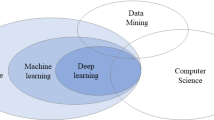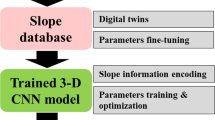Abstract
Wheeled mobile robots (WMR) are often applied to travel on outdoor unstructured environment, such as loose soil or variable field terrain. Learning the knowledge of terrain has played a significant role for better mobility and stability of WMR. In this study, a diagonal recurrent neural network-based adaptive method is proposed to identify terrain parameters by the platform of a single driving wheel. According to the classical terramechanics model of wheel–soil interaction, a decoupling simplification model is developed by closed-form analytical equations. Five unknown terrain parameters are divided into two groups and included in two complex nonlinear equations. These parameters are used to compute the model outputs of force and torque of wheel–soil interaction. Dynamic back propagation algorithm is applied to update these parameters for compensating the errors between the prediction of neural network and measurable data in real time. The results of simulation show that the terrain parameters can be obtained and approximate the experimental value of terrain parameters when the predictive errors converge to zero.






Similar content being viewed by others
References
Wong JY (2001) Theory of ground vehicles. Wiley, USA
Iagnemma K, Kang S, Shibly H, Dubowsky S (2004) Online terrain parameter estimation for wheeled mobile robots with application to planetary rovers. IEEE Trans Robot 20(5):921–927
Iagnemma K, Senatore C, Trease B et al (2011) Terramechanics modeling of Mars surface exploration rovers for simulation and parameter estimation. In: Proceedings of the ASME international design engineering technical conference and computers and information in engineering conference, Washington, DC
Moreland S, Skonieczny K, Wettergreen D (2012) Motion analysis system for robot traction device evaluation and design. In: Proceedings of the international conference on field and service robotics, Sendai, Japan
Ding L, Deng Z, Gao H et al (2014) Interaction mechanics model for rigid driving wheels of planetary rovers moving on sandy terrain with consideration of multiple physical effects. J Field Robot. doi:10.1002/rob.21533
Zhang G, Eddy PB, Michael HY (1998) Forecasting with artificial neural networks. The state of the art. Int J Forecast 14(1):35–62
Huang GB, Zhu Q, Siew C (2006) Real-time learning capability of neural networks. IEEE Trans Neural Netw 17(4):863–878
Yang CG, Li ZJ, Cui R, Xu B (2014) Neural network-based motion control of an underactuated wheeled inverted pendulum model. IEEE Trans Neural Netw Learn Syst 25(11):2004–2016
Cao F, Lin S, Xu Z (2010) Approximation capability of interpolation neural networks. Neurocomputing 74(1):457–460
Yang DS, Liu XR, Xu YK, Wang YC, Liu ZB (2013) State estimation of recurrent neural networks with interval time-varying delay: an improved delay-dependent approach. Neural Comput Appl 23(3–4):1149–1158
Yu DL, Chang TK (2005) Adaptation of diagonal recurrent neural network model. Neural Comput Appl 14(3):189–197
Ray LR, Brande DC, Lever JH (2009) Estimation of net traction for differential-steered wheeled robots. J Terrramech 46:75–87
Ding L, Yoshida K, Nagatani K, Gao HB, Deng ZQ (2009) Parameter identification for planetary soil based on decoupled analytical wheel–soil interaction terramechanics model. In: IEEE/RSJ international conference on intelligent robots and systems, pp 4122–4127
Ding L, Gao HB, Deng ZQ et al (2011) Experimental study and analysis on driving wheels’ performance for planetary exploration rovers moving in deformable soil. J Terramech 48:27–45
Li ZJ, Yang CG (2012) Neural-adaptive output feedback control of a class of transportation vehicles based on wheeled inverted pendulum models. IEEE Trans Control Syst Technol 20:1583–1591
Jung JR, Yum BJ (2011) Artificial neural network based approach for dynamic parameter design. Expert Syst Appl 38:504–510
Haykin SS (2009) Neural networks and learning machines, 3rd edn. Pearson Education, Upper Saddle River
Zhang R, Xu Z, Huang G, Wang D (2012) Global convergence of online BP training with dynamic learning rate. IEEE Trans Neural Netw Learn Syst 23(2):330–341
Modares H, Lewis FL, Naghibi-Sistani M (2013) Adaptive optimal control of unknown constrained-input systems using policy iteration and neural networks. IEEE Trans Neural Netw Learn Syst. 24(10):1513–1525
Mastorocostas PA, Hilas CS (2009) A block-diagonal recurrent fuzzy neural network for system identification. Neural Comput Appl 18(7):707–717
Acknowledgments
This study was supported in part by the National Natural Science Foundation of China (Grant No. 61370033/51275106), National Basic Research Program of China (Grant No. 2013CB035502), Fundamental Research Funds for the Central Universities (Grant No. HIT.BRETIII.201411), Self-Planned Task (No. SKLRS201401A01/SKLRS201501B) of State Key Laboratory of Robotics and System (HIT), Harbin Talent Programme for Distinguished Young Scholars (No. 2014RFYXJ001); and the “111 Project” (Grant No. B07018).
Author information
Authors and Affiliations
Corresponding authors
Rights and permissions
About this article
Cite this article
Song, X., Gao, H., Ding, L. et al. Diagonal recurrent neural networks for parameters identification of terrain based on wheel–soil interaction analysis. Neural Comput & Applic 28, 797–804 (2017). https://doi.org/10.1007/s00521-015-2107-5
Received:
Accepted:
Published:
Issue Date:
DOI: https://doi.org/10.1007/s00521-015-2107-5




